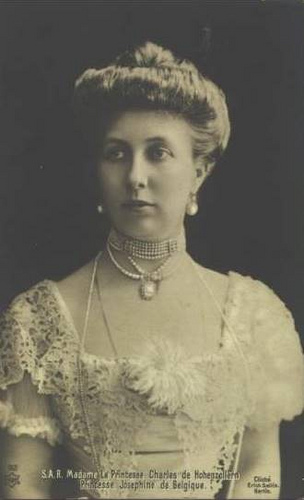
The House of Hohenzollern is a German royal dynasty whose members were variously princes, electors, kings and emperors of Hohenzollern, Brandenburg, Prussia, the German Empire, and Romania. The family came from the area around the town of Hechingen in Swabia during the late 11th century and took their name from Hohenzollern Castle. The first ancestors of the Hohenzollerns were mentioned in 1061.

Hohenzollern-Sigmaringen was a principality in Southwestern Germany. Its rulers belonged to the senior Swabian branch of the House of Hohenzollern. The Swabian Hohenzollerns were elevated to princes in 1623. The small sovereign state with the capital city of Sigmaringen was annexed to the Kingdom of Prussia in 1850 following the abdication of its sovereign in the wake of the revolutions of 1848, then became part of the newly created Province of Hohenzollern.
Mayen-Koblenz is a district (Kreis) in the north of Rhineland-Palatinate, Germany. Neighboring districts are Ahrweiler, Neuwied, Westerwaldkreis, district-free Koblenz, Rhein-Lahn, Rhein-Hunsrück, Cochem-Zell, and Vulkaneifel.

Sigmaringen is a town in southern Germany, in the state of Baden-Württemberg. Situated on the upper Danube, it is the capital of the Sigmaringen district.

Andernach is a town in the district of Mayen-Koblenz, in Rhineland-Palatinate, Germany, of about 30,000 inhabitants. It is situated towards the end of the Neuwied basin on the left bank of the Rhine between the former tiny fishing village of Fornich in the north and the mouth of the small river Nette in the southeast, just 13 miles (21 km) north of Koblenz, with its five external town districts: Kell, Miesenheim, Eich, Namedy, and Bad Tönisstein.

Karl Friedrich, Prince of Hohenzollern is the eldest son of the late Friedrich Wilhelm, Prince of Hohenzollern and Princess Margarita of Leiningen. He became head of the Roman Catholic Swabian branch of the House of Hohenzollern upon his father's death on 16 September 2010.

Stephanie Josepha Friederike Wilhelmine Antonia of Hohenzollern-Sigmaringen was Queen of Portugal as the wife of King Peter V.

Sigmaringen Castle was the princely castle and seat of government for the Princes of Hohenzollern-Sigmaringen. Situated in the Swabian Alb region of Baden-Württemberg, Germany, this castle dominates the skyline of the town of Sigmaringen. The castle was rebuilt following a fire in 1893, and only the towers of the earlier medieval fortress remain. Schloss Sigmaringen was a family estate of the Swabian Hohenzollern family, a cadet branch of the Hohenzollern family, from which the German Emperors and kings of Prussia came. During the closing months of World War II, Schloss Sigmaringen was briefly the seat of the Vichy French Government after France was liberated by the Allies. The castle and museums may be visited throughout the year, but only on guided tours. It is still owned by the Hohenzollern-Sigmaringen family, although they no longer reside there.

Princess Josephine Friederike Luise of Baden was Princess of Hohenzollern-Sigmaringen from 27 August 1848 to 7 December 1849 during the brief reign of her husband, Prince Karl Anton. Josephine was the second daughter of Charles, Grand Duke of Baden, and Stéphanie de Beauharnais. She was the mother of the first king of Romania, Carol I. Through her younger daughter Marie, she is the ancestress of the Belgian royal family and the grand ducal family of Luxembourg.

Princess Joséphine Caroline of Belgium was the youngest daughter of Prince Philippe, Count of Flanders and Princess Marie of Hohenzollern-Sigmaringen. She was an older sister of Albert I of Belgium.

Frederick, Prince of Hohenzollern was the eldest son of William, Prince of Hohenzollern and Princess Maria Teresa of Bourbon-Two Sicilies. He had a twin brother, Franz Joseph, Prince of Hohenzollern-Emden, who was born a few minutes after he was.

Princess Marie Luise Alexandra Karoline of Hohenzollern-Sigmaringen, later Countess of Flanders, was a princess of Hohenzollern-Sigmaringen, later simply of Hohenzollern. She married Prince Philippe, Count of Flanders, second son of King Leopold I of Belgium, and she was the mother of King Albert I.

Amalie Zephyrine of Salm-Kyrburg, was a German noblewoman by birth member of the House of Salm in the Salm-Kyrburg branch and through her marriage she was Princess of Hohenzollern-Sigmaringen.

Franz Joseph Maria Ludwig Anton Thassilo Prinz von Hohenzollern-Emden was a member of the Roman Catholic branch of the House of Hohenzollern. He was born as Prince Franz Joseph of Hohenzollern and adopted the surname Prinz von Hohenzollern-Emden in 1933.

Prince Frederick of Hohenzollern-Sigmaringen was a member of the House of Hohenzollern-Sigmaringen and a Prussian General of the Cavalry. He fought with distinction in the Franco-Prussian War. Frederick was the fifth child and youngest son of Charles Anthony, Prince of Hohenzollern and his wife Princess Josephine of Baden.

Princess Louise of Thurn and Taxis was the eldest child of Maximilian Anton, Hereditary Prince of Thurn and Taxis and Duchess Helene in Bavaria. Louise married Prince Frederick of Hohenzollern-Sigmaringen in 1879.

Prince Karl Anton of Hohenzollern-Sigmaringen was a member of the Princely House of Hohenzollern-Sigmaringen. Karl Anton was the third and youngest son of Leopold, Prince of Hohenzollern and his wife Infanta Antónia of Portugal. Karl Anton's elder brothers were William, Prince of Hohenzollern and Ferdinand I of Romania.
Karl, Prince of Hohenzollern-Sigmaringen was the reigning Prince of Hohenzollern-Sigmaringen from 1831 to 1848.
Princess Amalie Antoinette Karoline Adrienne of Hohenzollern-Sigmaringen was a member of the House of Hohenzollern-Sigmaringen and a Princess of Hohenzollern-Sigmaringen by birth. Through her marriage to Prince Eduard of Saxe-Altenburg, Amalie was also a member of the House of Saxe-Altenburg and Princess of Saxe-Altenburg. Amalie was a grand-niece of Joachim Murat, King of the Two Sicilies from 1808 to 1815 and a brother-in-law of Napoleon Bonaparte, through marriage to Napoleon's youngest sister, Caroline Bonaparte.
Anton Aloys, Prince of Hohenzollern-Sigmaringen was Prince of Hohenzollern-Sigmaringen.



















